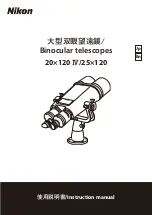
13
D. Let Your Eyes Dark-Adapt
Do not expect to go from a lighted house into the darkness of
the outdoors at night and immediately see faint nebulas,
galaxies, and star clusters- or even very many stars, for that
matter. Your eyes take about 30 minutes to reach perhaps
80% of their full dark-adapted sensitivity. Many observers
notice improvements after several hours of total darkness. As
your eyes become dark-adapted, more stars will glimmer into
view and you will be able to see fainter details in objects you
view in your telescope. Exposing your eyes to very bright day-
light for extended periods of time can adversely affect your
night vision for days. So give yourself at least a little while to
get used to the dark before you begin observing.
To see what you are doing in the darkness, use a red-filtered
flashlight rather than a white light. Red light does not spoil
your eyes’ dark adaptation like white light does. A flashlight
with a red LED light is ideal, or you can cover the front of a
regular incandescent flashlight with red cellophane or paper.
Beware, too, that nearby porch and streetlights and automo-
bile headlights will spoil your night vision.
Tracking Celestial Objects
The Earth is constantly rotating about its polar axis, complet-
ing one full rotation every 24 hours; this is what defines a
“day”. We do not feel the Earth rotating, but we can tell that it
is at night by seeing the apparent movement of stars from
east to west. This movement translates into a rate of .25° per
minute, or 15 arc-seconds per second. (There are 60 arc-min-
utes in 1°, and 60 arc-seconds in one arc-minute.) This is
called the sidereal rate.
When you observe any astronomical object, you are watching
a moving target. This means the telescope’s position must be
slowly updated over time to keep an object in the field of view.
To keep the object in the telescope’s field of view (to “track”
it), the telescope must be moved by small increments every
now and then, in the direction the object is moving. This is
easy to do with a SkyQuest XT10 Dobsonian because of its
buttery smooth motion on both axes. As the object moves off
toward the edge of the field of view, you just lightly nudge the
telescope to bring it back to the center.
You will notice that it is more difficult to track objects when the
telescope tube is aimed nearly straight up. This is inherent to
the basic design of the Dobsonian, and stems from the fact
that there is very little leverage to move in azimuth when the
tube is in a near-vertical position. To gain more leverage, try
grasping the tube close to the altitude side bearings with both
hands. Also, when looking overhead, if the telescope cannot
be moved any more in altitude, rotate the telescope 180° in
azimuth to continue motion.
Remember that objects appear to move across the field of
view faster at higher magnifications. This is because the field
of view becomes narrower.
Eyepiece Selection
By using eyepieces of varying focal lengths, it is possible to
attain many magnifications with the SkyQuest XT10
Dobsonian. The telescopes come with two high-quality Plossl
eyepieces: a 25mm, which gives a magnification of 50x, and
a 9mm, which gives a magnification of 139x. Other eyepieces
can be used to achieve higher or lower powers. It is quite
common for an observer to own five or more eyepieces to
access a wide range of magnifications. This allows the
observer to choose the best eyepiece to use depending on
the object being viewed. At least to begin with, the two sup-
plied eyepieces will suffice nicely.
Whatever you choose to view, always start by inserting your
lowest power (longest focal length) eyepiece to locate and
center the object. Low magnification yields a wide field of
view, which shows a larger area of sky in the eyepiece. This
makes acquiring and centering an object much easier. If you
try to find and center objects with high power (narrow field of
view), it’s like trying to find a needle in a haystack!
Once you’ve centered the object in the eyepiece, you can
switch to higher magnification (shorter focal length eyepiece),
if you wish. This is especially recommended for small and
bright objects, like planets and double stars. The Moon also
takes higher magnifications well.
Deep-sky objects, however, typically look better at medium or
low magnifications. This is because many of them are quite
faint, yet have some extent (apparent width). Deep-sky
objects will often disappear at higher magnifications, since
greater magnification inherently yields dimmer images. This is
not the case for all deep-sky objects, however. Many galaxies
are quite small, yet are somewhat bright, so higher power
may show more detail.
The best rule of thumb with eyepiece selection is to start with
a low power, wide field, and then work your way up in magni-
fication. If the object looks better, try an even higher
magnification. If the object looks worse, then back off the
magnification a little by using a lower power eyepiece.
Use of 2" Eyepieces
The SkyQuest XT10 comes with a large format focuser
(Figure 9) as standard equipment. Because of its large size,
it is able to accept eyepieces that have a 2" barrel diameter.
2" eyepieces are desirable because they allow for a wider
field of view than 1.25" eyepieces. Many observers own at
least one 2" eyepiece to yield the largest field of view possi-
ble for looking at wide deep sky objects, such as open star
clusters and gaseous nebulae. 2" eyepieces can also give
nice views of the Moon.
To use a 2" eyepiece, simply remove the 1.25" eyepiece
adapter from the end of the focuser drawtube. You must first
loosen the two thumb screws on the 2" eyepiece adapter to
do this. Now, insert a 2" eyepiece into the focuser, and secure
it with the two thumb screws. Focus the eyepiece as
described previously.
You’ll be stunned at the wide fields of view that 2" eye-
pieces can deliver. It makes you feel like you’re floating
through space!
Objects to Observe
Now that you are all set up and ready to go, one critical deci-
sion must be made: what to look at?


































